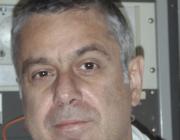Abstract:
{The Kozani earthquake (Ms = 6.6) of 13 May 1995 is the strongest event of the decade in Greece and occurred in a region of low seismic activity. Using regional data and the strong-motion record at the Kozani station, we relocate the mainshock at 40.183° N and 21.660° E, beneath the Vourinos massif at a depth of 14.2 km. We also compute a focal mechanism by body-waveform modeling at teleseismic distance, which confirms a normal mechanism. The most likely plane strikes 240° ± 1° N and dips 40° ± 1° N with a centroid depth of 11 ± 1 km. Modeling of the strong-motion record at Kozani confirms that nucleation started at the eastern termination of the bottom of the fault.Six days after the mainshock, we installed a network of 40 portable seismological stations for one week around the epicentral region. Several thousand aftershocks were recorded, among which we locate 622 with a precision better than 1 km. We compute 181 focal mechanisms that mostly show normal faulting. The aftershock seismicity is restricted between 5 and 15 km depth and defines a plane dipping north at an angle of about 35°, consistent with the mainshock mechanism. Seismic activity with the same pattern of normal fault mechanisms is also seen on an antithetic fault connected to the main one at 12 km depth, which cuts the ground surface north of the Vourinos ophiolite massif in the Siatista valley. These results suggest two possibilities for the active fault plane; either it is the Deskati fault that is flat and dips with a constant angle, and therefore the surface breaks are secondary features, or, more likely, it is the Paleohori fault that is new, of listric shape, and located ahead of the Deskati fault, which was not active during the earthquake.}

